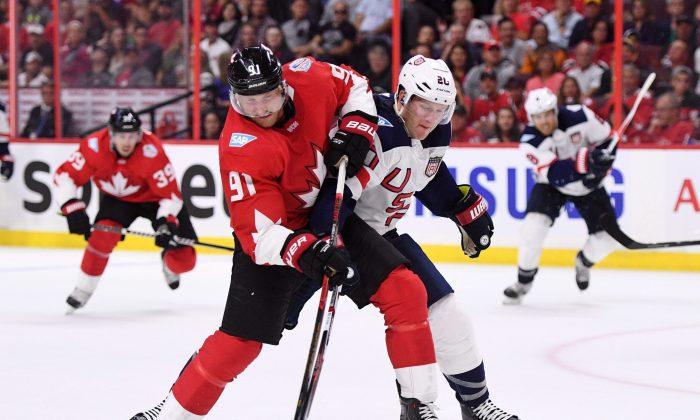OTTAWA—The World Cup of Hockey, last staged in 2004, brings back the tradition of the old Canada Cup, in which the strongest hockey nations competed with their best players. Since 2004, the most compelling international hockey has taken place at the Winter Olympics. But not anymore.
While some purists may take umbrage with the term “World Cup” given continental teams like Europe and North America, what’s more important is that every attempt has been made to make this World Cup of Hockey a best-on-best international tournament.
Playing in the World Cup is a big deal. Just ask Team Canada forward Brad Marchand. When he got the call to join the team, he said it was the best call he could have received.
“I teared up right away and everything kind of balled up into one emotion,” Marchand said after Monday’s practice. “The years of training and dedication all came down to this and I was so proud to be part of this team.”
On international hockey’s biggest stage, the situation in soccer—where a legendary talent like Ryan Giggs never played in a major international tournament because his nation (Wales) never had the depth to qualify—has been remedied.
Now deserving players like L.A. Kings captain Anze Kopitar of Slovenia and Mats Zuccarello of Norway can face hockey’s superpowers with a quality supporting cast as their respective nations are blended into a continental team of sorts.
“Some players who don’t normally get to play in these tournaments, it’s good for them,” Team Canada winger Corey Perry told Epoch Times.
It’s also convenient that Team Europe helps the tournament achieve that perfect balance of eight teams; its players represent eight countries.
The other team that helps get the tournament to eight teams and that is getting all the pre-tournament attention is Team North America—the best players 23 and under from Canada and the U.S. The average age of the team is 22.2 years, which is six years less than the average age of all the other teams.

The quality in Team North America’s squad is downright scary with 10 of 23 players chosen in the top five of their draft years, including five first-overall selections.
Jay Bouwmeester, one of two Team Canada players to play in the 2004 World Cup along with Thornton, says the new format is definitely different and more exciting for North American fans.
“You get a lot more NHL players that they’re familiar with,” Bouwmeester said.
“If you’re a fan, you sit back and watch the future of the National Hockey League,” Canada head coach Mike Babcock said about Team North America. “If I’m a hockey fan, I’m interested in watching them for sure.”
Today’s hockey is about speed and skill and these youngsters have displayed it in abundance in two pre-tournament wins over Team Europe.
The traditional six hockey powers of Canada, Russia, USA, Finland, Sweden, and Czech Republic won’t have any “minnows” in their round robin groups.
“You’ve got to prove yourself every day when you go out there. There are no games that will be handed to you,” Perry said.
‘Jump right into it’
For Pittsburgh and San Jose players who competed in the Stanley Cup final in June, the intensity of competition has returned quickly.
“It’s intense hockey to start right into, but at the same time it’s nice too,” Sidney Crosby said. “You jump right into it, you’re not feeling your way through it.”
Top players get used to playing against each other, but Perry says the right pre-tournament games can get everybody together on the same team quickly.
“The game the other night in Columbus brought everybody together pretty quickly,” Perry said referring to Team USA’s physical 4–2 win over Canada on Sept. 9. “It was intense and that as a whole brought people together pretty quickly.”
And given Bouwmeester’s wealth of experience playing in these top-level international tournaments, he says coming together effectively is key.
“I always think in these tournaments teams that really come together, can play a structure, every one finds their roles the quickest, turn out to have the most success,” Bouwmeester said.
Canada stormed to gold at the 2014 Sochi Olympics and has 14 returning players including its head coach.
If Canada is to win again, it’s shaping up to be a more difficult challenge.
“Every team is so talented and every team is very deep,” Marchand said. “Every game is going to be a battle and we know that.”
The World Cup of Hockey is expected to run regularly going forward. It aims to be the Holy Grail for hockey fans.
Follow Rahul on Twitter @RV_ETSports





